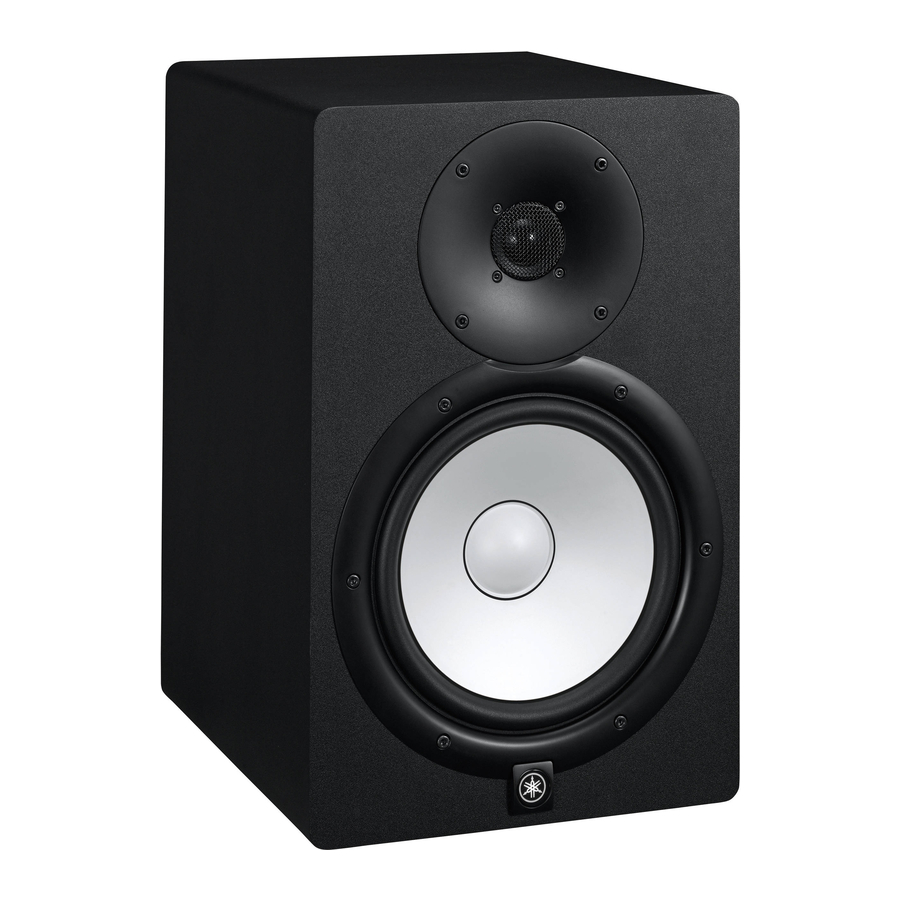Yamaha HS50M Instrukcja obsługi - Strona 11
Przeglądaj online lub pobierz pdf Instrukcja obsługi dla System głośników Yamaha HS50M. Yamaha HS50M 17 stron. Hs series powered monitor speaker
Również dla Yamaha HS50M: Instrukcja obsługi (16 strony), Instrukcja serwisowa (27 strony)

Fine-tuning for Surround
Set the HS50M or HS80M LEVEL control to about 12
o'clock to set the nominal input level to
approximately +4dB. If you're using the HS50M
set the HS10W LEVEL control to about 10 o'clock,
and if you're using the HS80M set it to about 11
o'clock. You can then fine-adjust the HS10W LEVEL
control as required. Another approach would be to
adjust the HS50M/HS80M output level to achieve
the desired relative balance with the subwoofer.
* If you're using the HS50M with a digital mixer, set the
HS10W LEVEL control to about 9 o'clock. If you're using
the HS80M with a digital mixer set the HS10W LEVEL
control to about 10 o'clock.
Start with the HIGH CUT control set at its center
click position, which corresponds to a HPF frequency
of about 100 Hz*. The HIGH CUT frequency can be
adjusted later to achieve the smoothest integration
with the HS50M or HS80M speakers.
* Set to 80 Hz if you're using a digital mixer.
Turn the HS10W LOW CUT switch ON. Adjust the
LOW CUT control to achieve the desired degree of
bass extension.
Set the HS50M/HS80M LOW CUT switch to "100
Hz"*.
* Set to 80 Hz if you're using a digital mixer.
When set to "-2 dB" the HS50M/HS80M EQ MID
switch attenuates the midrange frequencies slightly
to produce a somewhat "softer" sound that may be
better for listening or long monitoring sessions. For
accurate monitoring, however, set the MID switch
to "0".
Set the HS50M/HS80M ROOM CONTROL switch
according to the distance your speakers are placed
from the nearest wall (refer to "Proximity to Walls
and Corners", above).
For accurate monitoring set the HS50M/HS80M
HIGH TRIM switch to "0". This switch can be set to
"-2 dB" to attenuate the highs slightly if you find the
sound too bright.
Maintain a Consistent
Monitoring Level
Another difference between listening and monitoring is
that when you're listening for enjoyment you probably
listen at significantly different levels at different times: from
soft and unobtrusive for background music, right though
room-shaking for involved listening or dancing. This is
definitely not the case for serious monitoring. The response
of your ears changes so drastically according to level,
especially in the soft to medium-loud region, that is
essential to maintain a consistent monitoring level
otherwise you simply won't get consistent mixing results.
You'll undoubtedly need to turn up or down a bit at
certain points during the production process when
listening for specific problems or effects — in fact it is
important to listen to your mix at different levels as a final
checking process, bringing the levels down very low to
check if any elements of the mix disappear and make sure
that the vocal continues to maintain its balance in the mix
at very low levels — but in general you should stay within a
fairly small range.
Just what is the best level to monitor at? Although there
is a "standard" monitoring level specification,* the answer
for most small studios is "whatever is most comfortable for
you." You need to monitor at a level that's loud enough so
that you don't miss any soft details, but not so loud that
your ears become fatigued (or your neighbors complain). If
you find yourself turning up the volume after monitoring
for a short while, your ears are probably starting to get
tired and losing sensitivity. This is obviously bad for your
music as well as your ears. So find that "comfort zone" and
prepare to make some great music.
* For you techies, the SMPTE RP 200 standard monitoring level is
83 dB SPL (RMS average) at the listening position, or if you're
mixing for film you'll need to know that the standard Dolby
monitoring level for surround is 85 dB SPL.
HS80M/HS50M/HS10W Owner's Manual
11
